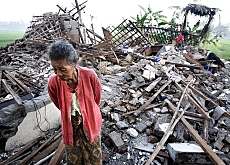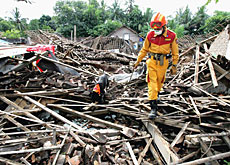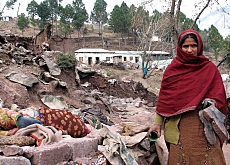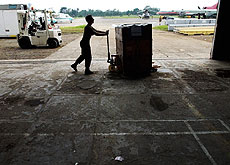Study of earthquakes needs closer attention

A Swiss expert at a seismology conference in Germany says Switzerland is playing a leading role in the study of earthquakes.
But Domenico Giardini, professor of seismology at the Federal Institute of Technology in Zurich, admitted that there was still a lot of work to be done to limit the damage caused by natural disasters.
The Global Science Forum of the Organisation for Economic Cooperation and Development has just held a two-day workshop, Earthquake Science and its Contribution to Society, in Potsdam, Germany.
It brought together about 60 leading scientists and science agency officials from around the world, including developing countries.
“Topics of discussion included access to real-time data,” said Giardini, who is also director of the Swiss Seismological Service. “This has improved in recent years but there remains much room for improvement.”
Earthquake prediction remains a major driving force in seismology and Giardini said another theme was how scientists understood the physics and the probabilities of earthquakes “and how that is being translated into engineering”.
Communication
Earthquakes are a major natural hazard all around the world – in May more than 6,000 people died in an earthquake which measured 6.3 on the Richter scale in Java, Indonesia, and last October a quake with a magnitude of 7.6 in Pakistan and the Indian Kashmir region left at least 75,000 dead.
The Indian Ocean earthquake on December 26, 2004 had a magnitude of 9.15 and triggered a series of tsunamis which killed around 220,000 people.
Giardini says scientists can nevertheless get a lot of data from such disasters. “We also learnt that local administration was unprepared,” he told swissinfo. “Even the procedures on how to pass the alerts to the people sitting on the beach. Obviously the systems were not prepared for that.”
He agreed that lack of communication was as big a problem as lack of scientific knowledge.
“Absolutely. The scientific knowledge might have been present but the main difficulty was how to change it into operational procedures that could save lives.”
“We have this information in our texts when we teach in the university, but how do we make sure people can use it?”
Experience
Another aim of the forum was to compare national and regional approaches, plans, projects and priorities.
Giardini said Switzerland had a large role internationally because it currently has the five-year leadership of the global federation of the seismic networks. This meant it had access to all the data exchanges and procedures between agencies.
As seen by the recent rockslide by the Gotthard tunnel which crushed a car and killed two people, Switzerland is also affected by natural accidents.
“We have a lot of experience, especially in multi-risk issues – when an earthquake triggers a landslide which triggers waves in a lake and so on,” Giardini explained.
“But joining the various risks is normally a major issue because waves are treated by the oceanographic community – even when the triggering mechanism is an earthquake, and the two communities are usually totally detached.”
Giardini said there should be a more holistic approach to all the aspects of such natural disasters.
swissinfo, Thomas Stephens
May 27, 2006: 6.3 magnitude earthquake in Java, Indonesia, kills more than 6,000 people.
October 8, 2005: 7.6 magnitude quake in Pakistan and India Kashmir region leaves at least 75,000 dead.
March 28, 2005: Tremor on the island of Nias, Indonesia, kills 905 people.
December 26, 2004: Quake near Sumatra causes a tsunami that hits a dozen countries in southeastern Asia. 220,000 dead or missing.
December 26, 2003: Quake in Bam, Iran, leaves 31,000 dead.
Experts believe the most dangerous natural catastrophes are single events like earthquakes and not those that occur regularly like floods.
The seismic threat to Switzerland is considered moderate to medium. The most exposed areas are Valais, Basel, the Rhine valley in St Gallen and Graubünden.
Between 300 and 400 earth tremors are recorded every year in Switzerland.
The last earthquake to cause any real damage happened in 1991 in Graubünden.

In compliance with the JTI standards
More: SWI swissinfo.ch certified by the Journalism Trust Initiative




You can find an overview of ongoing debates with our journalists here. Please join us!
If you want to start a conversation about a topic raised in this article or want to report factual errors, email us at english@swissinfo.ch.